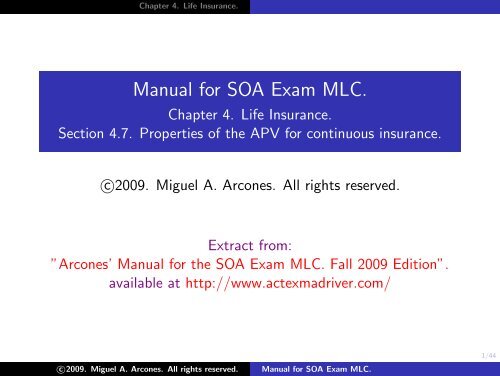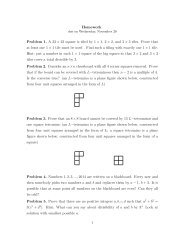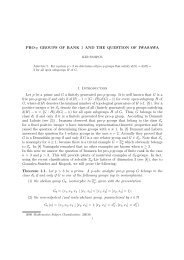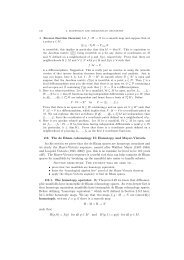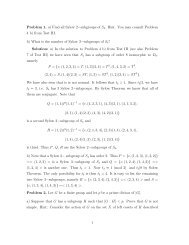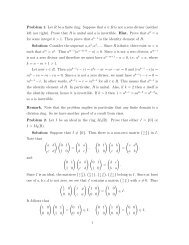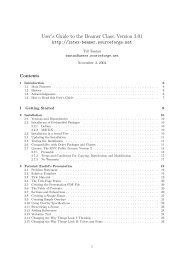Manual for SOA Exam MLC.
Manual for SOA Exam MLC.
Manual for SOA Exam MLC.
Create successful ePaper yourself
Turn your PDF publications into a flip-book with our unique Google optimized e-Paper software.
Chapter 4. Life Insurance.<br />
<strong>Manual</strong> <strong>for</strong> <strong>SOA</strong> <strong>Exam</strong> <strong>MLC</strong>.<br />
Chapter 4. Life Insurance.<br />
Section 4.7. Properties of the APV <strong>for</strong> continuous insurance.<br />
c○2009. Miguel A. Arcones. All rights reserved.<br />
Extract from:<br />
”Arcones’ <strong>Manual</strong> <strong>for</strong> the <strong>SOA</strong> <strong>Exam</strong> <strong>MLC</strong>. Fall 2009 Edition”.<br />
available at http://www.actexmadriver.com/<br />
c○2009. Miguel A. Arcones. All rights reserved. <strong>Manual</strong> <strong>for</strong> <strong>SOA</strong> <strong>Exam</strong> <strong>MLC</strong>.<br />
1/44
Chapter 4. Life Insurance. Section 4.7. Properties of the APV <strong>for</strong> continuous insurance.<br />
Properties of the APV <strong>for</strong> continuous insurance<br />
The following table shows the definition of all the variables in the<br />
previous section:<br />
type of insurance payment<br />
whole life insurance Z x = ν Tx<br />
n–year term life insurance Z 1<br />
x:n| = νTx I (Tx ≤ n)<br />
n–year deferred life insurance n|Z x = νTx I (n < Tx)<br />
n–year pure endowment life insurance Z 1<br />
x:n| = νnI (n < Tx)<br />
min(Tx n–year endowment life insurance Z x:n| = ν ,n)<br />
c○2009. Miguel A. Arcones. All rights reserved. <strong>Manual</strong> <strong>for</strong> <strong>SOA</strong> <strong>Exam</strong> <strong>MLC</strong>.<br />
2/44
Theorem 1<br />
We have that<br />
Z x = Z 1<br />
x:n| + n|Z x,<br />
Ax = A 1<br />
x:n| + n|Ax,<br />
2 Ax = 2 A 1<br />
x:n| + 2 n|Ax,<br />
Chapter 4. Life Insurance. Section 4.7. Properties of the APV <strong>for</strong> continuous insurance.<br />
Var(Zx) = Var(Z 1 x:n| ) + Var(n|Z x) − 2A 1<br />
x:n| · n|Ax<br />
Cov(Z 1<br />
x:n|, n|Z x) = −A 1<br />
x:n| · n|Ax = 1<br />
�<br />
A<br />
2<br />
1<br />
x:n| 2 + n|Ax 2 − Ax 2�<br />
.<br />
c○2009. Miguel A. Arcones. All rights reserved. <strong>Manual</strong> <strong>for</strong> <strong>SOA</strong> <strong>Exam</strong> <strong>MLC</strong>.<br />
3/44
Theorem 2<br />
We have that<br />
Z x:n| = Z 1<br />
x:n| + Z 1<br />
x:n|,<br />
A x:n| = A 1<br />
x:n| + A 1<br />
x:n|,<br />
2 Ax:n| = 2 A 1<br />
x:n| + 2 A 1<br />
x:n|,<br />
Chapter 4. Life Insurance. Section 4.7. Properties of the APV <strong>for</strong> continuous insurance.<br />
Var(Z x:n|) = Var(Z 1<br />
x:n|) + Var(Z 1<br />
x:n|) − 2A 1<br />
x:n| · A 1<br />
Cov(Z 1<br />
x:n|, Z 1<br />
x:n|) = −A 1<br />
x:n| · A 1<br />
x:n| = 1<br />
2<br />
x:n|<br />
�<br />
A 1<br />
x:n| 2 + A 1<br />
x:n| 2 − A x:n| 2 �<br />
.<br />
c○2009. Miguel A. Arcones. All rights reserved. <strong>Manual</strong> <strong>for</strong> <strong>SOA</strong> <strong>Exam</strong> <strong>MLC</strong>.<br />
4/44
Theorem 3<br />
We have that<br />
Chapter 4. Life Insurance. Section 4.7. Properties of the APV <strong>for</strong> continuous insurance.<br />
n|Ax = nExAx+n.<br />
c○2009. Miguel A. Arcones. All rights reserved. <strong>Manual</strong> <strong>for</strong> <strong>SOA</strong> <strong>Exam</strong> <strong>MLC</strong>.<br />
5/44
Theorem 3<br />
We have that<br />
Proof: We have that<br />
n|Ax =<br />
=ν n npx<br />
Chapter 4. Life Insurance. Section 4.7. Properties of the APV <strong>for</strong> continuous insurance.<br />
� ∞<br />
n � ∞<br />
0<br />
n|Ax = nExAx+n.<br />
ν t tpxµx+t dt =<br />
� ∞<br />
ν t tpx+nµx+n+t dt = nExAx+n.<br />
0<br />
ν t+n n+tpxµx+n+t dt<br />
c○2009. Miguel A. Arcones. All rights reserved. <strong>Manual</strong> <strong>for</strong> <strong>SOA</strong> <strong>Exam</strong> <strong>MLC</strong>.<br />
6/44
Theorem 3<br />
We have that<br />
Proof: We have that<br />
n|Ax =<br />
=ν n npx<br />
Corollary 1<br />
Chapter 4. Life Insurance. Section 4.7. Properties of the APV <strong>for</strong> continuous insurance.<br />
� ∞<br />
n � ∞<br />
0<br />
n|Ax = nExAx+n.<br />
ν t tpxµx+t dt =<br />
� ∞<br />
ν t tpx+nµx+n+t dt = nExAx+n.<br />
Ax = A 1<br />
x:n| + nExAx+n.<br />
0<br />
ν t+n n+tpxµx+n+t dt<br />
c○2009. Miguel A. Arcones. All rights reserved. <strong>Manual</strong> <strong>for</strong> <strong>SOA</strong> <strong>Exam</strong> <strong>MLC</strong>.<br />
7/44
Chapter 4. Life Insurance. Section 4.7. Properties of the APV <strong>for</strong> continuous insurance.<br />
<strong>Exam</strong>ple 1<br />
Suppose that δ = 0.04 and (x) has <strong>for</strong>ce of mortality µ = 0.03.<br />
Calculate:<br />
c○2009. Miguel A. Arcones. All rights reserved. <strong>Manual</strong> <strong>for</strong> <strong>SOA</strong> <strong>Exam</strong> <strong>MLC</strong>.<br />
8/44
Chapter 4. Life Insurance. Section 4.7. Properties of the APV <strong>for</strong> continuous insurance.<br />
<strong>Exam</strong>ple 1<br />
Suppose that δ = 0.04 and (x) has <strong>for</strong>ce of mortality µ = 0.03.<br />
Calculate:<br />
(i) Ax and Var(Z x).<br />
c○2009. Miguel A. Arcones. All rights reserved. <strong>Manual</strong> <strong>for</strong> <strong>SOA</strong> <strong>Exam</strong> <strong>MLC</strong>.<br />
9/44
Chapter 4. Life Insurance. Section 4.7. Properties of the APV <strong>for</strong> continuous insurance.<br />
<strong>Exam</strong>ple 1<br />
Suppose that δ = 0.04 and (x) has <strong>for</strong>ce of mortality µ = 0.03.<br />
Calculate:<br />
(i) Ax and Var(Z x).<br />
Solution: (i) We have that<br />
Ax = µ<br />
µ + δ =<br />
0.03<br />
= 0.4285714286,<br />
0.03 + 0.04<br />
2<br />
Ax = µ<br />
µ + 2δ =<br />
0.03<br />
= 0.2727272727,<br />
0.03 + (2)(0.04)<br />
Var(Z x) = 2 Ax − (Ax) 2 = 0.2727272727 − (0.428571428) 2<br />
=0.0890538038.<br />
c○2009. Miguel A. Arcones. All rights reserved. <strong>Manual</strong> <strong>for</strong> <strong>SOA</strong> <strong>Exam</strong> <strong>MLC</strong>.<br />
10/44
Chapter 4. Life Insurance. Section 4.7. Properties of the APV <strong>for</strong> continuous insurance.<br />
<strong>Exam</strong>ple 1<br />
Suppose that δ = 0.04 and (x) has <strong>for</strong>ce of mortality µ = 0.03.<br />
Calculate:<br />
(ii) A 1<br />
x:10| and Var(Z 1<br />
x:10|).<br />
c○2009. Miguel A. Arcones. All rights reserved. <strong>Manual</strong> <strong>for</strong> <strong>SOA</strong> <strong>Exam</strong> <strong>MLC</strong>.<br />
11/44
Chapter 4. Life Insurance. Section 4.7. Properties of the APV <strong>for</strong> continuous insurance.<br />
<strong>Exam</strong>ple 1<br />
Suppose that δ = 0.04 and (x) has <strong>for</strong>ce of mortality µ = 0.03.<br />
Calculate:<br />
(ii) A 1<br />
x:10| and Var(Z 1<br />
x:10|).<br />
Solution: (ii) We have that<br />
A 1<br />
x:10| = e −10δ 10px = e −(10)(0.04) e −(10)(0.03) = e −0.7 = 0.4965853038,<br />
2 A 1<br />
x:10| = e −10(2)δ 10px = e −(10)(2)(0.04) e −(10)(0.03) = e −0.11<br />
=0.3328710837,<br />
Var(Z 1<br />
x:10|) = 2 A 1<br />
x:10| − A 1 2<br />
x:10| = 0.3328710837 − (0.4965853038) 2<br />
=0.08627411975.<br />
c○2009. Miguel A. Arcones. All rights reserved. <strong>Manual</strong> <strong>for</strong> <strong>SOA</strong> <strong>Exam</strong> <strong>MLC</strong>.<br />
12/44
Chapter 4. Life Insurance. Section 4.7. Properties of the APV <strong>for</strong> continuous insurance.<br />
<strong>Exam</strong>ple 1<br />
Suppose that δ = 0.04 and (x) has <strong>for</strong>ce of mortality µ = 0.03.<br />
Calculate:<br />
(iii) 10|Ax and Var(10|Z x).<br />
c○2009. Miguel A. Arcones. All rights reserved. <strong>Manual</strong> <strong>for</strong> <strong>SOA</strong> <strong>Exam</strong> <strong>MLC</strong>.<br />
13/44
Chapter 4. Life Insurance. Section 4.7. Properties of the APV <strong>for</strong> continuous insurance.<br />
<strong>Exam</strong>ple 1<br />
Suppose that δ = 0.04 and (x) has <strong>for</strong>ce of mortality µ = 0.03.<br />
Calculate:<br />
(iii) 10|Ax and Var(10|Z x).<br />
Solution: (iii) We have that<br />
10|Ax = nExAx+n = (0.4965853038)(0.4285714286) = 0.2128222731,<br />
2 10|Ax = 2 nEx · 2 Ax+n = (0.3328710837)(0.2727272727)<br />
=0.09078302282,<br />
Var(10|Z x) = 0.09078302282 − (0.2128222731) 2 = 0.04548970289.<br />
c○2009. Miguel A. Arcones. All rights reserved. <strong>Manual</strong> <strong>for</strong> <strong>SOA</strong> <strong>Exam</strong> <strong>MLC</strong>.<br />
14/44
Chapter 4. Life Insurance. Section 4.7. Properties of the APV <strong>for</strong> continuous insurance.<br />
<strong>Exam</strong>ple 1<br />
Suppose that δ = 0.04 and (x) has <strong>for</strong>ce of mortality µ = 0.03.<br />
Calculate:<br />
(iv) A 1<br />
x:10| and Var(Z 1<br />
x:10|).<br />
c○2009. Miguel A. Arcones. All rights reserved. <strong>Manual</strong> <strong>for</strong> <strong>SOA</strong> <strong>Exam</strong> <strong>MLC</strong>.<br />
15/44
Chapter 4. Life Insurance. Section 4.7. Properties of the APV <strong>for</strong> continuous insurance.<br />
<strong>Exam</strong>ple 1<br />
Suppose that δ = 0.04 and (x) has <strong>for</strong>ce of mortality µ = 0.03.<br />
Calculate:<br />
(iv) A 1<br />
x:10| and Var(Z 1<br />
x:10|).<br />
Solution: (iv) We have that<br />
A 1<br />
x:10| = Ax − 10|Ax = 0.4285714286 − 0.2128222731 = 0.2157491555,<br />
2 A 1<br />
x:10| = 2 Ax − 2 10|Ax = 0.2727272727 − 0.09078302282<br />
=0.1819442499,<br />
Var(Z 1<br />
x:10|) = 2 A 1<br />
x:10| − A 1 2<br />
x:10| = 0.1819442499 − (0.2157491555) 2<br />
=0.1353965518.<br />
c○2009. Miguel A. Arcones. All rights reserved. <strong>Manual</strong> <strong>for</strong> <strong>SOA</strong> <strong>Exam</strong> <strong>MLC</strong>.<br />
16/44
Chapter 4. Life Insurance. Section 4.7. Properties of the APV <strong>for</strong> continuous insurance.<br />
<strong>Exam</strong>ple 1<br />
Suppose that δ = 0.04 and (x) has <strong>for</strong>ce of mortality µ = 0.03.<br />
Calculate:<br />
(v) A x:10| and Var(Z x:10| ).<br />
c○2009. Miguel A. Arcones. All rights reserved. <strong>Manual</strong> <strong>for</strong> <strong>SOA</strong> <strong>Exam</strong> <strong>MLC</strong>.<br />
17/44
Chapter 4. Life Insurance. Section 4.7. Properties of the APV <strong>for</strong> continuous insurance.<br />
<strong>Exam</strong>ple 1<br />
Suppose that δ = 0.04 and (x) has <strong>for</strong>ce of mortality µ = 0.03.<br />
Calculate:<br />
(v) A x:10| and Var(Z x:10| ).<br />
Solution: (v) We have that<br />
A x:10| = A 1<br />
x:10| + A 1<br />
x:10| = 0.2157491555 + 0.4965853038<br />
=0.7123344593,<br />
2 Ax:10| = 2 A 1<br />
x:10| + 2 A 1<br />
x:10| = 0.1819442499 + 0.3328710837<br />
=0.5148153336,<br />
Var(Z 1<br />
x:10|) = 2 A 1<br />
x:10| − A 1 2<br />
x:10| = 0.5148153336 − (0.7123344593) 2<br />
=0.007394951694.<br />
c○2009. Miguel A. Arcones. All rights reserved. <strong>Manual</strong> <strong>for</strong> <strong>SOA</strong> <strong>Exam</strong> <strong>MLC</strong>.<br />
18/44
Chapter 4. Life Insurance. Section 4.7. Properties of the APV <strong>for</strong> continuous insurance.<br />
Theorem 4<br />
Suppose that the survival function is s(x) = e−µx , 0 ≤ x. Then,<br />
(i) Ax = µ<br />
µ+δ .<br />
(ii) A 1<br />
x:n| = e−n(µ+δ) .<br />
(iii) n|Ax = e−n(µ+δ µ<br />
µ+δ .<br />
(iv) A 1<br />
x:n| = (1 − e−n(µ+δ) ) µ<br />
µ+δ .<br />
(v) Ax:n| = (1 − e−n(µ+δ) ) µ<br />
µ+δ + e−n(µ+δ) .<br />
c○2009. Miguel A. Arcones. All rights reserved. <strong>Manual</strong> <strong>for</strong> <strong>SOA</strong> <strong>Exam</strong> <strong>MLC</strong>.<br />
19/44
Chapter 4. Life Insurance. Section 4.7. Properties of the APV <strong>for</strong> continuous insurance.<br />
Theorem 4<br />
Suppose that the survival function is s(x) = e−µx , 0 ≤ x. Then,<br />
(i) Ax = µ<br />
µ+δ .<br />
(ii) A 1<br />
x:n| = e−n(µ+δ) .<br />
(iii) n|Ax = e−n(µ+δ µ<br />
µ+δ .<br />
(iv) A 1<br />
x:n| = (1 − e−n(µ+δ) ) µ<br />
µ+δ .<br />
(v) Ax:n| = (1 − e−n(µ+δ) ) µ<br />
µ+δ + e−n(µ+δ) .<br />
Proof: (i) follows from a previous theorem.<br />
c○2009. Miguel A. Arcones. All rights reserved. <strong>Manual</strong> <strong>for</strong> <strong>SOA</strong> <strong>Exam</strong> <strong>MLC</strong>.<br />
20/44
Chapter 4. Life Insurance. Section 4.7. Properties of the APV <strong>for</strong> continuous insurance.<br />
Theorem 4<br />
Suppose that the survival function is s(x) = e−µx , 0 ≤ x. Then,<br />
(i) Ax = µ<br />
µ+δ .<br />
(ii) A 1<br />
x:n| = e−n(µ+δ) .<br />
(iii) n|Ax = e−n(µ+δ µ<br />
µ+δ .<br />
(iv) A 1<br />
x:n| = (1 − e−n(µ+δ) ) µ<br />
µ+δ .<br />
(v) Ax:n| = (1 − e−n(µ+δ) ) µ<br />
µ+δ + e−n(µ+δ) .<br />
Proof: (ii)<br />
A 1<br />
x:n| = e −nδ · npx = e −n(µ+δ) .<br />
c○2009. Miguel A. Arcones. All rights reserved. <strong>Manual</strong> <strong>for</strong> <strong>SOA</strong> <strong>Exam</strong> <strong>MLC</strong>.<br />
21/44
Chapter 4. Life Insurance. Section 4.7. Properties of the APV <strong>for</strong> continuous insurance.<br />
Theorem 4<br />
Suppose that the survival function is s(x) = e−µx , 0 ≤ x. Then,<br />
(i) Ax = µ<br />
µ+δ .<br />
(ii) A 1<br />
x:n| = e−n(µ+δ) .<br />
(iii) n|Ax = e−n(µ+δ µ<br />
µ+δ .<br />
(iv) A 1<br />
x:n| = (1 − e−n(µ+δ) ) µ<br />
µ+δ .<br />
(v) Ax:n| = (1 − e−n(µ+δ) ) µ<br />
µ+δ + e−n(µ+δ) .<br />
Proof: (iii)<br />
−n(µ+δ) µ<br />
n|Ax = nExAx+n = e<br />
µ + δ .<br />
c○2009. Miguel A. Arcones. All rights reserved. <strong>Manual</strong> <strong>for</strong> <strong>SOA</strong> <strong>Exam</strong> <strong>MLC</strong>.<br />
22/44
Chapter 4. Life Insurance. Section 4.7. Properties of the APV <strong>for</strong> continuous insurance.<br />
Theorem 4<br />
Suppose that the survival function is s(x) = e−µx , 0 ≤ x. Then,<br />
(i) Ax = µ<br />
µ+δ .<br />
(ii) A 1<br />
x:n| = e−n(µ+δ) .<br />
(iii) n|Ax = e−n(µ+δ µ<br />
µ+δ .<br />
(iv) A 1<br />
x:n| = (1 − e−n(µ+δ) ) µ<br />
µ+δ .<br />
(v) Ax:n| = (1 − e−n(µ+δ) ) µ<br />
µ+δ + e−n(µ+δ) .<br />
Proof: (iv)<br />
A 1<br />
x:n| = Ax − n|Ax = µ<br />
µ<br />
− e−n(µ+δ)<br />
µ + δ µ + δ<br />
=(1 − e −n(µ+δ) ) µ<br />
µ + δ .<br />
c○2009. Miguel A. Arcones. All rights reserved. <strong>Manual</strong> <strong>for</strong> <strong>SOA</strong> <strong>Exam</strong> <strong>MLC</strong>.<br />
23/44
Chapter 4. Life Insurance. Section 4.7. Properties of the APV <strong>for</strong> continuous insurance.<br />
Theorem 4<br />
Suppose that the survival function is s(x) = e−µx , 0 ≤ x. Then,<br />
(i) Ax = µ<br />
µ+δ .<br />
(ii) A 1<br />
x:n| = e−n(µ+δ) .<br />
(iii) n|Ax = e−n(µ+δ µ<br />
µ+δ .<br />
(iv) A 1<br />
x:n| = (1 − e−n(µ+δ) ) µ<br />
µ+δ .<br />
(v) Ax:n| = (1 − e−n(µ+δ) ) µ<br />
µ+δ + e−n(µ+δ) .<br />
Proof: (v)<br />
A x:n| = A 1<br />
x:n| + A 1<br />
x:n| = (1 − e −n(µ+δ) ) µ<br />
µ + δ + e−n(µ+δ) .<br />
c○2009. Miguel A. Arcones. All rights reserved. <strong>Manual</strong> <strong>for</strong> <strong>SOA</strong> <strong>Exam</strong> <strong>MLC</strong>.<br />
24/44
Chapter 4. Life Insurance. Section 4.7. Properties of the APV <strong>for</strong> continuous insurance.<br />
<strong>Exam</strong>ple 2<br />
Find the APV of a 15-year term life insurance to (x) with unity<br />
payment if δ = 0.06 and (x) has a constant <strong>for</strong>ce of mortality<br />
µ = 0.05.<br />
c○2009. Miguel A. Arcones. All rights reserved. <strong>Manual</strong> <strong>for</strong> <strong>SOA</strong> <strong>Exam</strong> <strong>MLC</strong>.<br />
25/44
Chapter 4. Life Insurance. Section 4.7. Properties of the APV <strong>for</strong> continuous insurance.<br />
<strong>Exam</strong>ple 2<br />
Find the APV of a 15-year term life insurance to (x) with unity<br />
payment if δ = 0.06 and (x) has a constant <strong>for</strong>ce of mortality<br />
µ = 0.05.<br />
Solution: We have that<br />
A 1<br />
x:15| = (0.05)(1 − e−(15)(0.05+0.06) )<br />
=0.3672500415.<br />
0.05 + 0.06<br />
= (0.05)(1 − e−(15)(0.11) )<br />
0.11<br />
c○2009. Miguel A. Arcones. All rights reserved. <strong>Manual</strong> <strong>for</strong> <strong>SOA</strong> <strong>Exam</strong> <strong>MLC</strong>.<br />
26/44
Chapter 4. Life Insurance. Section 4.7. Properties of the APV <strong>for</strong> continuous insurance.<br />
Theorem 5<br />
Assume de Moivre’s law with terminal age ω and that ω and x are<br />
positive integers. Then,<br />
(i) Ax = a ω−x|i<br />
ω−x .<br />
(ii) A 1<br />
x:n| = e<br />
−nδ ω−x−n<br />
ω−x .<br />
(iii) n|Ax = e −nδ a ω−x−n|i<br />
ω−x .<br />
(iv) A 1<br />
x:n| = a n|i<br />
ω−x .<br />
(v) A x:n| = a n|i<br />
ω−x<br />
+ e−nδ ω−x−n<br />
ω−x .<br />
c○2009. Miguel A. Arcones. All rights reserved. <strong>Manual</strong> <strong>for</strong> <strong>SOA</strong> <strong>Exam</strong> <strong>MLC</strong>.<br />
27/44
Chapter 4. Life Insurance. Section 4.7. Properties of the APV <strong>for</strong> continuous insurance.<br />
Theorem 5<br />
Assume de Moivre’s law with terminal age ω and that ω and x are<br />
positive integers. Then,<br />
(i) Ax = a ω−x|i<br />
ω−x .<br />
(ii) A 1<br />
x:n| = e<br />
−nδ ω−x−n<br />
ω−x .<br />
(iii) n|Ax = e −nδ a ω−x−n|i<br />
ω−x .<br />
(iv) A 1<br />
x:n| = a n|i<br />
ω−x .<br />
(v) A x:n| = a n|i<br />
ω−x<br />
+ e−nδ ω−x−n<br />
ω−x .<br />
Proof: (i) It follows from a previous theorem.<br />
c○2009. Miguel A. Arcones. All rights reserved. <strong>Manual</strong> <strong>for</strong> <strong>SOA</strong> <strong>Exam</strong> <strong>MLC</strong>.<br />
28/44
Chapter 4. Life Insurance. Section 4.7. Properties of the APV <strong>for</strong> continuous insurance.<br />
Theorem 5<br />
Assume de Moivre’s law with terminal age ω and that ω and x are<br />
positive integers. Then,<br />
(i) Ax = a ω−x|i<br />
ω−x .<br />
(ii) A 1<br />
x:n| = e<br />
−nδ ω−x−n<br />
ω−x .<br />
(iii) n|Ax = e −nδ a ω−x−n|i<br />
ω−x .<br />
(iv) A 1<br />
x:n| = a n|i<br />
ω−x .<br />
(v) A x:n| = a n|i<br />
ω−x<br />
Proof: (ii)<br />
+ e−nδ ω−x−n<br />
ω−x .<br />
A 1<br />
x:n| = e −nδ · npx = e<br />
−nδ ω − x − n<br />
.<br />
ω − x<br />
c○2009. Miguel A. Arcones. All rights reserved. <strong>Manual</strong> <strong>for</strong> <strong>SOA</strong> <strong>Exam</strong> <strong>MLC</strong>.<br />
29/44
Chapter 4. Life Insurance. Section 4.7. Properties of the APV <strong>for</strong> continuous insurance.<br />
Theorem 5<br />
Assume de Moivre’s law with terminal age ω and that ω and x are<br />
positive integers. Then,<br />
(i) Ax = a ω−x|i<br />
ω−x .<br />
(ii) A 1<br />
x:n| = e<br />
−nδ ω−x−n<br />
ω−x .<br />
(iii) n|Ax = e −nδ a ω−x−n|i<br />
ω−x .<br />
(iv) A 1<br />
x:n| = a n|i<br />
ω−x .<br />
(v) A x:n| = a n|i<br />
ω−x<br />
Proof: (iii)<br />
+ e−nδ ω−x−n<br />
ω−x .<br />
−nδ ω − x − n<br />
n|Ax = nExAx+n = e<br />
ω − x<br />
a ω−x−n|i<br />
ω − x − n = e−nδ a ω−x−n|i<br />
ω − x .<br />
c○2009. Miguel A. Arcones. All rights reserved. <strong>Manual</strong> <strong>for</strong> <strong>SOA</strong> <strong>Exam</strong> <strong>MLC</strong>.<br />
30/44
Chapter 4. Life Insurance. Section 4.7. Properties of the APV <strong>for</strong> continuous insurance.<br />
Theorem 5<br />
Assume de Moivre’s law with terminal age ω and that ω and x are<br />
positive integers. Then,<br />
(i) Ax = a ω−x|i<br />
ω−x .<br />
(ii) A 1<br />
x:n| = e<br />
−nδ ω−x−n<br />
ω−x .<br />
(iii) n|Ax = e −nδ a ω−x−n|i<br />
ω−x .<br />
(iv) A 1<br />
x:n| = a n|i<br />
ω−x .<br />
(v) A x:n| = a n|i<br />
ω−x<br />
+ e−nδ ω−x−n<br />
ω−x .<br />
Proof: (iv) It follows from a previous theorem.<br />
c○2009. Miguel A. Arcones. All rights reserved. <strong>Manual</strong> <strong>for</strong> <strong>SOA</strong> <strong>Exam</strong> <strong>MLC</strong>.<br />
31/44
Chapter 4. Life Insurance. Section 4.7. Properties of the APV <strong>for</strong> continuous insurance.<br />
Theorem 5<br />
Assume de Moivre’s law with terminal age ω and that ω and x are<br />
positive integers. Then,<br />
(i) Ax = a ω−x|i<br />
ω−x .<br />
(ii) A 1<br />
x:n| = e<br />
−nδ ω−x−n<br />
ω−x .<br />
(iii) n|Ax = e −nδ a ω−x−n|i<br />
ω−x .<br />
(iv) A 1<br />
x:n| = a n|i<br />
ω−x .<br />
(v) A x:n| = a n|i<br />
ω−x<br />
Proof: (v)<br />
+ e−nδ ω−x−n<br />
ω−x .<br />
A x:n| = A 1<br />
x:n| + A 1<br />
x:n| = a n|i<br />
ω − x<br />
ω − x − n<br />
+ e−nδ .<br />
ω − x<br />
c○2009. Miguel A. Arcones. All rights reserved. <strong>Manual</strong> <strong>for</strong> <strong>SOA</strong> <strong>Exam</strong> <strong>MLC</strong>.<br />
32/44
Chapter 4. Life Insurance. Section 4.7. Properties of the APV <strong>for</strong> continuous insurance.<br />
<strong>Exam</strong>ple 3<br />
Julia is 40 year old. She buys a 15-year term deferred life policy<br />
insurance which will pay $50,000 at the time of her death. Suppose<br />
that the survival function is s(x) = 1 − x<br />
100 , 0 ≤ x ≤ 100. Suppose<br />
that the continuously compounded rate of interest is δ = 0.05.<br />
c○2009. Miguel A. Arcones. All rights reserved. <strong>Manual</strong> <strong>for</strong> <strong>SOA</strong> <strong>Exam</strong> <strong>MLC</strong>.<br />
33/44
Chapter 4. Life Insurance. Section 4.7. Properties of the APV <strong>for</strong> continuous insurance.<br />
<strong>Exam</strong>ple 3<br />
Julia is 40 year old. She buys a 15-year term deferred life policy<br />
insurance which will pay $50,000 at the time of her death. Suppose<br />
that the survival function is s(x) = 1 − x<br />
100<br />
, 0 ≤ x ≤ 100. Suppose<br />
that the continuously compounded rate of interest is δ = 0.05.<br />
(i) Find the actuarial present value of the benefit of this life insurance.<br />
c○2009. Miguel A. Arcones. All rights reserved. <strong>Manual</strong> <strong>for</strong> <strong>SOA</strong> <strong>Exam</strong> <strong>MLC</strong>.<br />
34/44
Chapter 4. Life Insurance. Section 4.7. Properties of the APV <strong>for</strong> continuous insurance.<br />
<strong>Exam</strong>ple 3<br />
Julia is 40 year old. She buys a 15-year term deferred life policy<br />
insurance which will pay $50,000 at the time of her death. Suppose<br />
that the survival function is s(x) = 1 − x<br />
100<br />
, 0 ≤ x ≤ 100. Suppose<br />
that the continuously compounded rate of interest is δ = 0.05.<br />
(i) Find the actuarial present value of the benefit of this life insurance.<br />
1<br />
Solution: (i) The density of T40 is fT40 (t) = 60 , 0 ≤ t ≤ 60.<br />
Hence,<br />
15|Ax = e −(15)(0.05) a 60−15|i<br />
60<br />
= e−0.75 − e −3<br />
3<br />
= 0.1408598281.<br />
= e−(15)(0.05) 1 − e−(45)(0.05)<br />
(0.05)(60)<br />
The actuarial present value is (50000)(0.1408598281) =<br />
7042.991405.<br />
c○2009. Miguel A. Arcones. All rights reserved. <strong>Manual</strong> <strong>for</strong> <strong>SOA</strong> <strong>Exam</strong> <strong>MLC</strong>.<br />
35/44
Chapter 4. Life Insurance. Section 4.7. Properties of the APV <strong>for</strong> continuous insurance.<br />
<strong>Exam</strong>ple 3<br />
Julia is 40 year old. She buys a 15-year term deferred life policy<br />
insurance which will pay $50,000 at the time of her death. Suppose<br />
that the survival function is s(x) = 1 − x<br />
100<br />
, 0 ≤ x ≤ 100. Suppose<br />
that the continuously compounded rate of interest is δ = 0.05.<br />
(ii) Find the standard deviation of the present value of the benefit<br />
of this life insurance.<br />
c○2009. Miguel A. Arcones. All rights reserved. <strong>Manual</strong> <strong>for</strong> <strong>SOA</strong> <strong>Exam</strong> <strong>MLC</strong>.<br />
36/44
Chapter 4. Life Insurance. Section 4.7. Properties of the APV <strong>for</strong> continuous insurance.<br />
<strong>Exam</strong>ple 3<br />
Julia is 40 year old. She buys a 15-year term deferred life policy<br />
insurance which will pay $50,000 at the time of her death. Suppose<br />
that the survival function is s(x) = 1 − x<br />
100<br />
, 0 ≤ x ≤ 100. Suppose<br />
that the continuously compounded rate of interest is δ = 0.05.<br />
(ii) Find the standard deviation of the present value of the benefit<br />
of this life insurance.<br />
Solution: (ii) We have that<br />
2 15|Ax = e −(15)(2)(0.05) a 60−15|(1+i) 2 −1<br />
60<br />
−(15)(0.05) 1 − e−(45)(2)(0.05)<br />
= e<br />
(2)(0.05)(60)<br />
= e−1.5 − e−6 = 0.03677523466,<br />
6<br />
Var(50000 · 15|Z x) = (50000) 2 (0.03677523466 − (0.1408598281) 2 )<br />
=42334358.72.<br />
c○2009. Miguel A. Arcones. All rights reserved. <strong>Manual</strong> <strong>for</strong> <strong>SOA</strong> <strong>Exam</strong> <strong>MLC</strong>.<br />
37/44
Chapter 4. Life Insurance. Section 4.7. Properties of the APV <strong>for</strong> continuous insurance.<br />
<strong>Exam</strong>ple 3<br />
Julia is 40 year old. She buys a 15-year term deferred life policy<br />
insurance which will pay $50,000 at the time of her death. Suppose<br />
that the survival function is s(x) = 1 − x<br />
100<br />
, 0 ≤ x ≤ 100. Suppose<br />
that the continuously compounded rate of interest is δ = 0.05.<br />
(ii) Find the standard deviation of the present value of the benefit<br />
of this life insurance.<br />
Solution: (ii)The standard deviation of 50000 · 15|Z x is<br />
√ 42334358.72 = 6506.485896.<br />
c○2009. Miguel A. Arcones. All rights reserved. <strong>Manual</strong> <strong>for</strong> <strong>SOA</strong> <strong>Exam</strong> <strong>MLC</strong>.<br />
38/44
Chapter 4. Life Insurance. Section 4.7. Properties of the APV <strong>for</strong> continuous insurance.<br />
<strong>Exam</strong>ple 4<br />
Julia is 40 year old. She buys a 15–year endowment policy<br />
insurance which will pay $50,000 at the time of her death, or in 15<br />
years whatever comes first. Suppose that the survival function is<br />
s(x) = 1 − x<br />
100 , 0 ≤ x ≤ 100. Suppose that the continuously<br />
compounded rate of interest is δ = 0.05.<br />
c○2009. Miguel A. Arcones. All rights reserved. <strong>Manual</strong> <strong>for</strong> <strong>SOA</strong> <strong>Exam</strong> <strong>MLC</strong>.<br />
39/44
Chapter 4. Life Insurance. Section 4.7. Properties of the APV <strong>for</strong> continuous insurance.<br />
<strong>Exam</strong>ple 4<br />
Julia is 40 year old. She buys a 15–year endowment policy<br />
insurance which will pay $50,000 at the time of her death, or in 15<br />
years whatever comes first. Suppose that the survival function is<br />
s(x) = 1 − x<br />
100 , 0 ≤ x ≤ 100. Suppose that the continuously<br />
compounded rate of interest is δ = 0.05.<br />
(i) Find the actuarial present value of the benefit of this life insurance.<br />
c○2009. Miguel A. Arcones. All rights reserved. <strong>Manual</strong> <strong>for</strong> <strong>SOA</strong> <strong>Exam</strong> <strong>MLC</strong>.<br />
40/44
Chapter 4. Life Insurance. Section 4.7. Properties of the APV <strong>for</strong> continuous insurance.<br />
<strong>Exam</strong>ple 4<br />
Julia is 40 year old. She buys a 15–year endowment policy<br />
insurance which will pay $50,000 at the time of her death, or in 15<br />
years whatever comes first. Suppose that the survival function is<br />
s(x) = 1 − x<br />
100 , 0 ≤ x ≤ 100. Suppose that the continuously<br />
compounded rate of interest is δ = 0.05.<br />
(i) Find the actuarial present value of the benefit of this life insurance.<br />
1<br />
Solution: (i) The density of T40 is fT40 (t) = 60 , 0 ≤ t ≤ 60.<br />
Hence,<br />
A40:15| = a15|i 100 − 40 − 15<br />
+ e−(15)(0.05)<br />
100 − 40 100 − 40<br />
= 1 − e−(15)(0.05) 45 1 − e−0.75<br />
+ e−0.75 = + e<br />
(0.05)(60) 60 3<br />
−0.75 (0.75) = 0.530152730<br />
The actuarial present value is (50000)(0.5301527303) =<br />
26507.63652.<br />
c○2009. Miguel A. Arcones. All rights reserved. <strong>Manual</strong> <strong>for</strong> <strong>SOA</strong> <strong>Exam</strong> <strong>MLC</strong>.<br />
41/44
Chapter 4. Life Insurance. Section 4.7. Properties of the APV <strong>for</strong> continuous insurance.<br />
<strong>Exam</strong>ple 4<br />
Julia is 40 year old. She buys a 15–year endowment policy<br />
insurance which will pay $50,000 at the time of her death, or in 15<br />
years whatever comes first. Suppose that the survival function is<br />
s(x) = 1 − x<br />
100 , 0 ≤ x ≤ 100. Suppose that the continuously<br />
compounded rate of interest is δ = 0.05.<br />
(ii) Find the standard deviation of the present value of the benefit<br />
of this life insurance.<br />
c○2009. Miguel A. Arcones. All rights reserved. <strong>Manual</strong> <strong>for</strong> <strong>SOA</strong> <strong>Exam</strong> <strong>MLC</strong>.<br />
42/44
Chapter 4. Life Insurance. Section 4.7. Properties of the APV <strong>for</strong> continuous insurance.<br />
<strong>Exam</strong>ple 4<br />
Julia is 40 year old. She buys a 15–year endowment policy<br />
insurance which will pay $50,000 at the time of her death, or in 15<br />
years whatever comes first. Suppose that the survival function is<br />
s(x) = 1 − x<br />
100 , 0 ≤ x ≤ 100. Suppose that the continuously<br />
compounded rate of interest is δ = 0.05.<br />
(ii) Find the standard deviation of the present value of the benefit<br />
of this life insurance.<br />
Solution: We have that<br />
2<br />
A40:15| = a15|(1+i) 2−1 100 − 40 − 15<br />
+ e−(15)(2)(0.05)<br />
100 − 40 100 − 40<br />
= 1 − e−(15)(2)(0.05) 45 1 − e−1.5<br />
+ e−1.5 = + e<br />
(2)(0.05)(60) 60 6<br />
−1.5 (0.75)<br />
=0.2968259268,<br />
Var(50000Z 40:15| ) = (50000) 2 (0.2968259268 − (0.5301527303) 2 )<br />
=39410023.39.<br />
c○2009. Miguel A. Arcones. All rights reserved. <strong>Manual</strong> <strong>for</strong> <strong>SOA</strong> <strong>Exam</strong> <strong>MLC</strong>.<br />
43/44
Chapter 4. Life Insurance. Section 4.7. Properties of the APV <strong>for</strong> continuous insurance.<br />
<strong>Exam</strong>ple 4<br />
Julia is 40 year old. She buys a 15–year endowment policy<br />
insurance which will pay $50,000 at the time of her death, or in 15<br />
years whatever comes first. Suppose that the survival function is<br />
s(x) = 1 − x<br />
100 , 0 ≤ x ≤ 100. Suppose that the continuously<br />
compounded rate of interest is δ = 0.05.<br />
(ii) Find the standard deviation of the present value of the benefit<br />
of this life insurance.<br />
Solution: The standard deviation of 50000Z 40:15| is<br />
√<br />
39410023.39 = 6277.740309.<br />
c○2009. Miguel A. Arcones. All rights reserved. <strong>Manual</strong> <strong>for</strong> <strong>SOA</strong> <strong>Exam</strong> <strong>MLC</strong>.<br />
44/44


